Crop care, in which the soil is piled to the base of the plants, is called hilling. At the base of the bushes, loose earthen mounds are formed in the form of knolls. They make a spud manually - with a hoe, a hoe, a disk hiller, a plow or with the help of a horse or tractor traction - a walk-behind tractor, a cultivator.
Content
Why spud potatoes
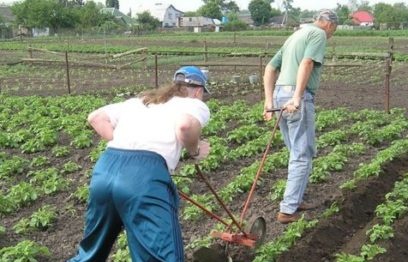
Hilling potatoes is an environmentally friendly replacement for herbicides. For potatoes, the soil should be light and loose. The point of hilling is to have lateral roots on which tubers will form. Sprinkling the earth prevents the growth of weeds. New grass is much easier to tear from loose soil. Loosening the soil gives oxygen and moisture access to the roots of plants.
Often overgrown bushes begin to fall apart in different directions, here comes the help of sprinkling soil. At the same time, bushes are collected, neat bushes form, tubers are not exposed. A mound of earth accumulates heat during the day; at night, it does not allow the bushes to freeze.
Why are potatoes being dumped:
- plants grow and develop more intensively;
- less nutrients are washed out of the soil;
- in earthed potatoes, the yield is 20-30% higher;
- plants are more resistant to winds and droughts;
- it is easier to dig potatoes from the soil;
- less green tubers;
- a minimum of weed grass;
- good access of air and water to the rhizome;
- photosynthesis is faster.
Do you always need to spud potatoes
It is believed that hilling is suitable only for the northern regions of the country and for wet soil. For the steppe regions, the procedure is ineffective. In such areas, deep landing helps to achieve results.
You can don’t spud vegetables at all, potato roots go deep into the ground, and plants can do without dumping. However, the stolons can grow up, in this case, you can not do without spuds. In the loose mound additional tubers are formed, productivity increases. Potatoes produce crops in moist and loose soil. The soil is loosened on the second day after rainy weather.
There is a technology for growing root crops without a spud; for this, the beds are covered with straw, black non-woven material, and potatoes are planted directly in green manure. When unlearned, the tops are not raised up, but spread on the ground. Vegetable growers have proved that this method of planting is no less effective than when hilling by the traditional method.
When and how many times do you need to spud potatoes
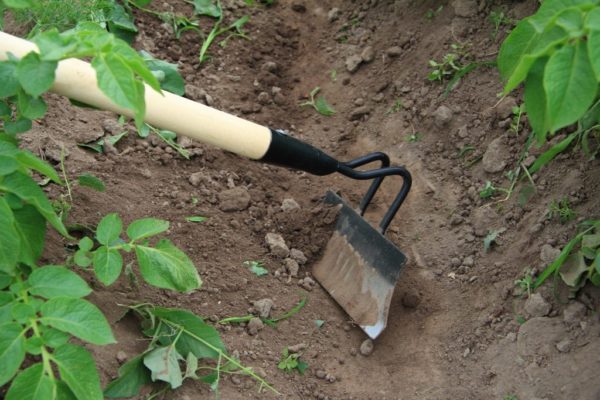
The date of planting of tubers depends on the weather, the selected variety, the area of growth. Each gardener chooses the timing of hilling potatoes for himself. He looks at the condition of his beds and decides when it is best to hoe vegetables. In the middle lane and northern regions, hilling is carried out immediately after the planting of tubers. Stalling is done in order to protect seedlings from night frost. Spud potatoes during the summer 2-3 times.
Estimated time of the spud:
- potatoes need to be erected for the first time when the bushes grow 15-20 cm in length;
- sprinkle the earth a second time 15-20 days after the first time;
- the third spud is done a month after the second procedure, usually two times is enough.
It is necessary to hush the bushes in the evening or in the morning, so that there is no sun. Work is easier, coolness saves plants from wilting.
Recommendations on how to spud potatoes
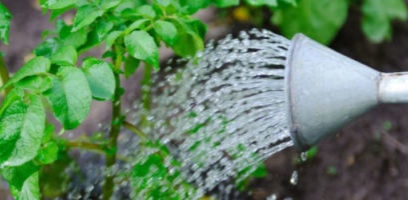
The potato loves to breathe, so it’s not worth it to plant deep. With light soil, the seal is 8 cm, with dense - 5 cm. The butt and weeding is carried out at the same time, it is so convenient. Large weeds that obscure the bushes are removed. Small grass dies itself after loosening the earth. An earth embankment is made 10-30 cm high, depending on the height of the bushes.
Advice:
- After a spud, you cannot water the plants from a hose, an earthen heap can “swim”, the work will be done in vain.
- In dry weather, before loosening, they moisten the earth, and then the beds are spudded.
- After a long rainy summer period, they wait 2-3 days for the earth to dry out, then they conduct a spud.
- Potatoes in rainy summer do not spud.
- If you spud potatoes during flowering, then the plants can lose buds.
How to spud potatoes: methods and tools
In a summer cottage area of 2-3 hundred parts, potatoes are loosened with a chopper. If the landing area is large, then manual processing is too time-consuming process. Summer residents use a walk-behind tractor, a disk hiller, a cultivator or a plow.
Hobbing potatoes manually with a hoe (hoe)
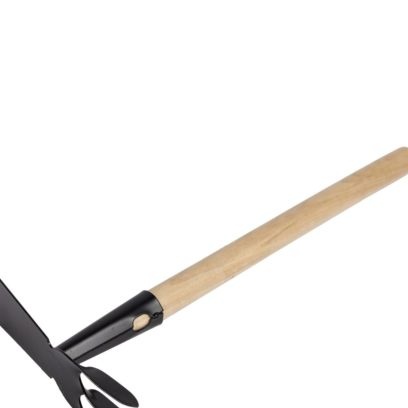
In order not to receive a sunstroke and not to harm the plants, the soil is loosened in the morning, after rain or watering. The chopper for hilling potatoes is triangular or trapezoidal in shape.
Traditional way
Hoeing the soil remains the traditional method for cultivating small areas. To spud potatoes manually you need a chopper, choose not a hot day after rain.
Hoe instruction:
- between the rows dig up the soil with a chopper;
- it is necessary to rake the earth in one direction;
- the soil is raked to one side of the bushes, then on the other hand this work is done in the opposite direction;
- it turns out to be a tall and wide embankment; on the top of the mound sticks of bushes stick out;
- at the end of the ridges make a recess for the accumulation of rainwater.
Fan method
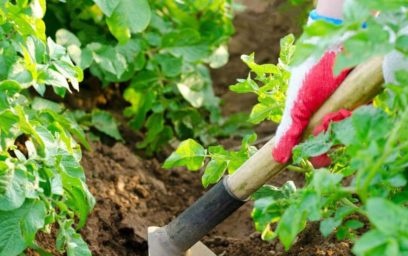
The fanning method is used when the bushes grow to 20 cm tall. A shovel, not a chopper, is suitable for this method. The method significantly increases productivity.
Processing Scheme:
- stalks are carefully spread and laid out on the ground in different directions;
- they pick up soil with a spatula and pour it into the middle of the bush;
- the ground is poured so that tops with leaves remain on the surface;
- on the embankment lay straw, dry grass;
- in a couple of days, the branches will direct growth up;
- after 15 days, the bush will stretch and grow, will form new shoots.
Zamyatkin hilling (similar to the previous one)
Zamyatkin, a vegetable grower from Siberia, proposed his method of hilling potatoes. He argued that traditional hoeing reduces yield. Inside the bush there is a struggle for light and moisture.
Okuchka according to Zamyatkin:
- tubers are planted in a checkerboard pattern in the range of 30-40 cm;
- when the seedlings grow 15-20 cm, the stems are pushed apart in different directions;
- in the center of the bush lay straw, grass, foliage, tops of plants remain on top;
- the crop grows 2 times;
Under the shelter, the soil retains moisture, the earth does not dry out, the tubers do not turn green. The Colorado potato beetle does not eat foliage and the sun does not burn bushes.
Motoblock
With a large-scale planting of potatoes, a rational and comfortable way is needed - earthing up with a walk-behind tractor.This is an expensive device for which you need to purchase fuel. But with large plantations of plantings with its help, you can quickly process the site. On the walk-behind tractor there are 2 cultivators in front and 1 plow in the rear.
It’s easy to work with the device, the processing time takes much less than if you spud potatoes with a chopper. If the distance between the rows is not the same, rhizome injury can occur.
 You may be interested in:
You may be interested in:Disc hiller
Okuchnik from disks can be made independently. It consists of a handle, two discs and a spine. The tilt of the structure is manually adjustable. The best option when the discs are bolted, they adjust the width between the discs. Okuchnik is able to process immediately 2 beds on one side or one bed on both sides.
Manual spuds process rows of various vegetable crops, not just potatoes. Manual spouts are mounted on a tractor or walk-behind tractor.
Cultivator
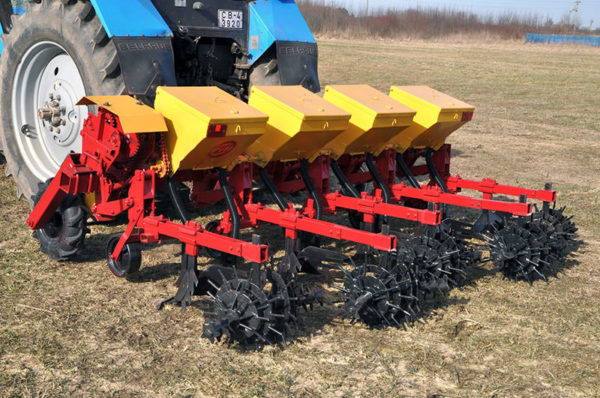
There are manual (mechanical) cultivators and automatic. A manual apparatus is cheaper, but the physical load during operation is much greater than working on an automatic cultivator. The devices are light, medium and heavy, weight from 10 to 40 kg. The difference between the devices in the depth of embedment is from 25 to 80 cm. Cultivators work on electricity or gasoline.
In addition to the ridges, cultivators grind blocks of earth, dig furrows for planting, and are suitable for applying sand or fertilizers. Using the apparatus they collect potatoes.
Plow
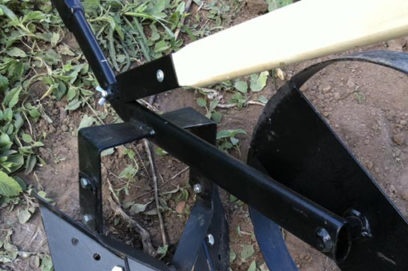
Plow - a manual device that helps to grow potatoes and other vegetables. A plow can pull a horse. If you weld a wheel to it, it will be easier to handle. The plow has a hiller in the form of a paw. Self-welded plow will be much cheaper than purchased in the store.
Plow Benefits:
- compactness;
- ease of use;
- maneuverability;
- the possibility of loosening by one person;
- low price.
Hilling potatoes helps increase yields by at least 30%. The procedure has a beneficial effect on the development of potato bushes. The supply of oxygen to the tubers helps to gain mass, and the foliage becomes lush. Glucose accumulates in the foliage, which dissolves and passes to root crops. This contributes to the accumulation of starch. Automatic tools for loosening the earth simplify and facilitate the work of man. Butt and loosening of potatoes help to grow tasty and large tubers.




 Description and description of varieties in Belarus with a photo
Description and description of varieties in Belarus with a photo Do I need to pick flowers from potatoes: why do they do it
Do I need to pick flowers from potatoes: why do they do it When to dig potatoes: timing and availability of new potatoes
When to dig potatoes: timing and availability of new potatoes How to grow a good potato crop: various methods and methods, planting and care
How to grow a good potato crop: various methods and methods, planting and care